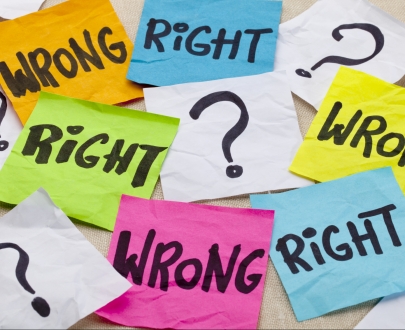
“When you judge others, you define yourself.”
It is a common human tendency to judge actions as good or bad. It’s a way to make sense of situations. While “judging” may be a term with negative connotations, if we replace it with “moral evaluation” or “ethical assessment” it can help us see this skill as a useful social tool.
Sparked by a curiosity to better understand how moral evaluations develop in children, a research team at the University of British Columbia led by Dr. Kiley Hamlin[1], works with very young infants and toddlers to explore the origins of “good and bad” judgements. Their conclusions are useful for parents and caregivers. In conversation with the Heart-Mind Online team, Dr. Hamlin encouraged adults to “TRUST that very young children notice kindness and goodness in others and GIVE young children many opportunities to 'help' in order to further develop these social qualities.”
In a series of experiments[2] in Dr. Hamlin’s lab, children either interact with puppets or watch short video clips. The children are then offered a choice between the character puppets. The behaviours of hundreds of children have revealed the answers to key research questions: Do babies distinguish good guys (helpful) from naughty guys (unhelpful) and if so, do they have a preference?
The conclusion? Infants and toddlers do recognize and show a sensitivity to "goodness" and they consistently prefer characters that engage in helping behaviours. In the first of two videos, the young subject was given a choice between two puppets after she had watched them perform in a scenario as either a helper or hinderer. She chooses the helper!
Because Dr. Hamlin studies babies as young as 3 months old to toddlers up to 3 years, she has also been able to make some conclusions[3] about the sequence of moral development. For example 3 month olds definitely do not like naughty guys but they aren’t yet able to distinguish between helpful or neutral behaviours. This indicates that in terms of a developmental timeline, knowing that “hurting is bad” comes first, followed by “helping is good.”
And the most heartwarming conclusion[4] is that toddlers are happiest when they get the opportunity to be both helpful and giving.
Dr. Kiley Hamlin is the Director of the UBC Centre for Infant Cognition and Canadian Research Chair. Her lab at the UBC Centre for Infant Cognition studies preverbal infants and young toddlers in order to study the foundational origins of evaluative processes.
In one experiment, dog and cat puppets act out helping and hindering behaviours. The protagonist puppet (a dog) attempts to open a box. At certain times, one cat puppet helps him open the box. In a second situation, a different cat puppet jumps on the box preventing the dog from opening the box.
Published in Developmental Science (2010), this study highlights the sequence of moral development based on experiments comparing six month olds and three month olds engaged in evaluating social behaviours.
Published in 2012, this study shows that 'giving' leads to happiness in young children before the age of two. Of note, children are happier after engaging in 'costly giving' (give up their own treats).